Forex Position Trading is a long-term strategy where traders hold positions for weeks, months, or even years to profit from significant price movements in the forex market. Unlike day trading or swing trading, which focus on short-term market fluctuations, position traders are more concerned with the overall trend and fundamental factors that influence currency values. This approach requires patience and a deep understanding of both technical analysis and fundamental analysis.
In this guide on Forex Position Trading Explained, we will explore the key strategies, concepts, and tools needed for successful long-term trading. Whether you’re new to forex or looking to adopt a longer-term strategy, position trading can offer stability and potential high returns by capitalizing on major trends driven by macroeconomic factors such as interest rates, inflation, and geopolitical events. By mastering this approach, traders can benefit from trend analysis, market sentiment, and economic indicators.
Table of Contents
What is Forex Position Trading?
Forex position trading is a long-term trading strategy where traders hold positions for extended periods, ranging from weeks to years. The goal is to capitalize on significant price movements driven by macroeconomic trends and fundamental factors, such as interest rates, inflation, and geopolitical events. Unlike short-term strategies like day trading or swing trading, position trading is less focused on daily market volatility and more on long-term market direction.
Position traders often use a combination of fundamental analysis and technical analysis to make informed decisions. They rely on macroeconomic data, such as GDP growth, central bank policies, and political stability, to predict the long-term direction of a currency pair. Additionally, trend analysis plays a key role, as traders aim to ride trends that last for months or even years.
Key Characteristics of Forex Position Trading:
- Long-Term Focus: Positions are held for extended periods, often several months or years.
- Macroeconomic Trends: Traders analyze global economic factors to determine long-term price direction.
- Less Frequent Trading: Fewer trades are made compared to short-term strategies, reducing the impact of daily market noise.
How does Forex Position Trading differ from Swing Trading?
Although both forex position trading and swing trading aim to capture market trends, the key difference lies in the timeframe and trade frequency. Swing trading focuses on medium-term trends, where traders hold positions for a few days to weeks, aiming to profit from short-term price swings. In contrast, position trading targets longer-term trends, with trades often lasting for months or years.
Position traders are more concerned with macroeconomic factors and broad market trends, while swing traders may focus more on technical signals and price patterns to enter and exit trades. Additionally, position trading requires less frequent monitoring of the market, as daily price fluctuations have little impact on the overall strategy. Swing traders, on the other hand, need to keep a closer eye on market conditions to time their entries and exits more precisely.
Differences Between Position Trading and Swing Trading:
- Time Frame: Position traders hold trades for months to years, while swing traders hold positions for days or weeks.
- Market Focus: Position traders focus on long-term trends influenced by fundamental factors, while swing traders rely on shorter-term technical analysis.
- Frequency of Trades: Position traders make fewer trades, while swing traders are more active in the market.
Which Trading Strategy is Right for You?
- Position Trading: Ideal for traders who prefer a hands-off, long-term approach and have a strong understanding of macroeconomic trends.
- Swing Trading: Best for traders who enjoy more frequent trading and are comfortable with short- to medium-term market movements.
What are the key concepts in Forex Position Trading?
Understanding the key concepts of forex position trading is essential for developing a successful long-term trading strategy. One of the most important aspects is trend identification. Position traders look for major trends that can last months or years, using both technical analysis and fundamental analysis to confirm these trends. By identifying strong upward or downward trends, traders can enter positions early and hold them for the long term.
Another important concept is patience. Unlike short-term trading strategies that rely on quick decision-making, position trading requires traders to remain patient and allow their trades to develop over time. This also involves managing risk through stop-loss orders and ensuring that trades are not exited prematurely due to short-term market fluctuations.
Key Concepts in Forex Position Trading:
- Trend Identification: Recognizing long-term trends using a combination of technical and fundamental analysis.
- Patience and Discipline: Staying committed to the trade plan and allowing trades to play out over months or years.
- Risk Management: Using stop-loss orders and proper position sizing to protect capital during extended trades.
Tools for Identifying Long-Term Trends
- Moving Averages: Long-term moving averages (e.g., 200-day MA) help traders identify the overall direction of the market.
- Fundamental Indicators: Interest rates, inflation, and GDP growth are crucial in determining long-term trends.
- Fibonacci Retracement Levels: These can help traders pinpoint potential entry points within a larger trend.
How do economic fundamentals influence Forex Position Trading?
Economic fundamentals play a pivotal role in forex position trading. Position traders focus on the broader macroeconomic picture, relying heavily on key economic indicators such as interest rates, inflation, and GDP growth to guide their decisions. These fundamentals help traders understand the long-term direction of a currency pair, as they reflect the health and stability of an economy.
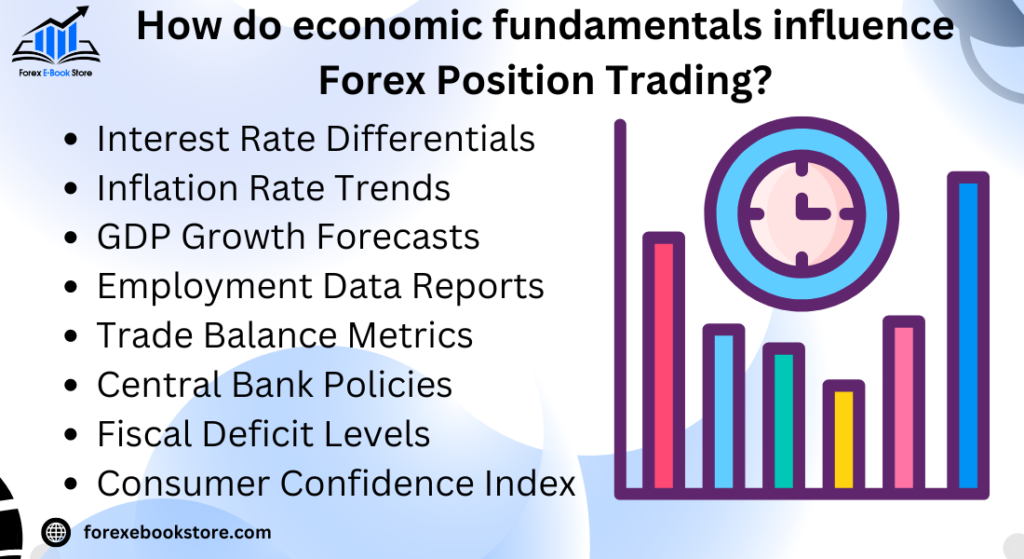
For instance, if a country’s central bank raises interest rates, its currency is likely to strengthen due to increased demand from foreign investors seeking higher returns. Similarly, strong GDP growth indicates a healthy economy, often leading to a stronger currency. Position traders look for such long-term economic trends to determine which currency pairs are likely to move in their favor over time.
Key Economic Fundamentals for Position Traders:
- Interest Rates: Higher interest rates generally attract foreign investment, strengthening a currency.
- Inflation Rates: High inflation can erode a currency’s value, while low inflation tends to support a stronger currency.
- GDP Growth: A growing economy supports a strong currency, while economic stagnation or recession can weaken it.
Using Economic Reports for Long-Term Position Trading
- Central Bank Reports: Monitor interest rate decisions and monetary policy statements.
- Inflation Data: Keep an eye on inflation reports, as they influence central bank policies.
- Employment Data: Strong employment numbers usually indicate economic growth, supporting the currency.
What are the best currency pairs for Position Trading?
Choosing the right currency pairs is crucial for successful forex position trading. Position traders typically favor major currency pairs such as EUR/USD, GBP/USD, and USD/JPY because they are highly liquid and often influenced by clear, long-term economic trends. These pairs tend to follow more predictable patterns over extended periods, making them ideal for long-term trades.
In addition to the major pairs, some traders may consider cross-currency pairs like EUR/GBP or AUD/JPY, especially if they show strong economic fundamentals driving long-term trends. The key is to focus on pairs that are influenced by stable, transparent economies with well-documented macroeconomic data, allowing traders to make informed decisions based on economic reports and analysis.
Top Currency Pairs for Forex Position Trading:
- EUR/USD: The most traded currency pair, offering high liquidity and clear trends driven by the U.S. and European economies.
- GBP/USD: Known for its volatility, but also for long-term trends influenced by UK and U.S. economic policies.
- USD/JPY: Often reflects the difference in economic policies between the U.S. Federal Reserve and the Bank of Japan.
Factors to Consider When Choosing Currency Pairs
- Liquidity: Major currency pairs offer high liquidity, ensuring ease of entry and exit even for long-term positions.
- Economic Stability: Choose pairs from countries with stable, transparent economic policies and reliable data.
- Trend Potential: Look for pairs with strong potential for long-term trends based on economic fundamentals.
How to choose the right time frames for Forex Position Trading?
Selecting the appropriate time frame is essential in forex position trading. Since position trading focuses on long-term trends, traders typically use higher time frames, such as daily, weekly, or monthly charts, to identify market trends and potential entry and exit points. These larger time frames smooth out short-term noise and provide a clearer view of the market’s overall direction.
Position traders usually rely on weekly or monthly charts for their primary analysis, while the daily chart helps fine-tune entry and exit points. By using higher time frames, position traders can avoid the volatility and randomness found in lower time frames (like 1-hour or 15-minute charts) and focus on more significant price movements that align with their long-term strategy.
Recommended Time Frames for Position Trading:
- Weekly Charts: Ideal for identifying long-term trends and key support and resistance levels.
- Monthly Charts: Used to confirm major market direction and provide a macro-level view of price movement.
- Daily Charts: Useful for refining entries and exits while keeping the broader trend in mind.
Combining Time Frames for Optimal Position Trading
- Top-Down Approach: Start with a higher time frame (e.g., monthly) to assess the overall trend, then move down to weekly and daily charts for precise entries.
- Multi-Time Frame Analysis: Ensure that the long-term and short-term charts align to confirm trend direction before entering a position.
What are the most effective strategies for Forex Position Trading?
In forex position trading, traders typically employ strategies that capitalize on long-term trends, using both technical and fundamental analysis to make informed decisions. These strategies involve identifying major market trends and holding positions for months or even years. Common strategies include trend following, buy and hold, and carry trading.
- Trend Following is the most popular approach in position trading, where traders identify a long-term trend using technical indicators such as moving averages or trendlines. Once a trend is confirmed, the trader enters a position in the direction of the trend and holds it until the trend shows signs of reversal.
- Buy and Hold is another common strategy, particularly for currencies backed by strong economic fundamentals. Traders purchase a currency with the expectation that it will appreciate over time and hold it for an extended period.
- Carry Trading involves borrowing in a currency with a low interest rate and investing in a currency with a higher interest rate. The trader profits from both the interest rate differential and potential currency appreciation.
Top Strategies for Forex Position Trading:
- Trend Following: Identify and ride long-term trends using technical indicators like moving averages and trendlines.
- Buy and Hold: Hold currencies backed by strong economies for extended periods, aiming for appreciation.
- Carry Trade: Profit from the interest rate differential between currencies with different interest rates.
Tools to Enhance Position Trading Strategies
- Moving Averages: Use long-term moving averages (e.g., 200-day) to confirm trends.
- Fibonacci Retracement: Helps traders identify potential entry points within a long-term trend.
- Interest Rate Differentials: Monitor interest rate policies from central banks to identify carry trade opportunities.
How to use technical indicators in Forex Position Trading?
Technical indicators are crucial for identifying long-term trends and confirming entry and exit points in forex position trading. Given the long-term nature of position trading, indicators such as moving averages, relative strength index (RSI), and Fibonacci retracement are commonly used to spot trends and potential reversals. These indicators provide a clear view of the market’s overall direction while filtering out short-term price noise.
Moving averages are particularly effective in position trading. Long-term averages, such as the 200-day moving average, help traders confirm the overall market trend and determine the right time to enter a position. RSI can be used to identify overbought or oversold conditions in the market, signaling when a currency may be poised for a reversal. Additionally, Fibonacci retracement levels are used to identify potential support and resistance levels, helping traders time their entries in a trending market.
Key Technical Indicators for Position Trading:
- 200-Day Moving Average: Confirms the long-term trend direction and helps traders avoid entering positions against the trend.
- RSI (Relative Strength Index): Identifies overbought or oversold conditions, signaling potential reversals.
- Fibonacci Retracement: Helps pinpoint key levels where price might retrace before continuing in the direction of the trend.
Combining Technical Indicators for Stronger Signals
- Trend Confirmation: Use the 200-day moving average to confirm the trend and RSI to time entries during pullbacks.
- Multiple Time Frame Analysis: Combine weekly and monthly charts to ensure the broader trend aligns with the shorter-term technical signals.
What role does fundamental analysis play in Forex Position Trading?
Fundamental analysis is a cornerstone of forex position trading, as it helps traders assess the long-term value of a currency based on macroeconomic factors. Traders rely on data such as interest rates, inflation, economic growth, and political stability to evaluate whether a currency is likely to strengthen or weaken over time.
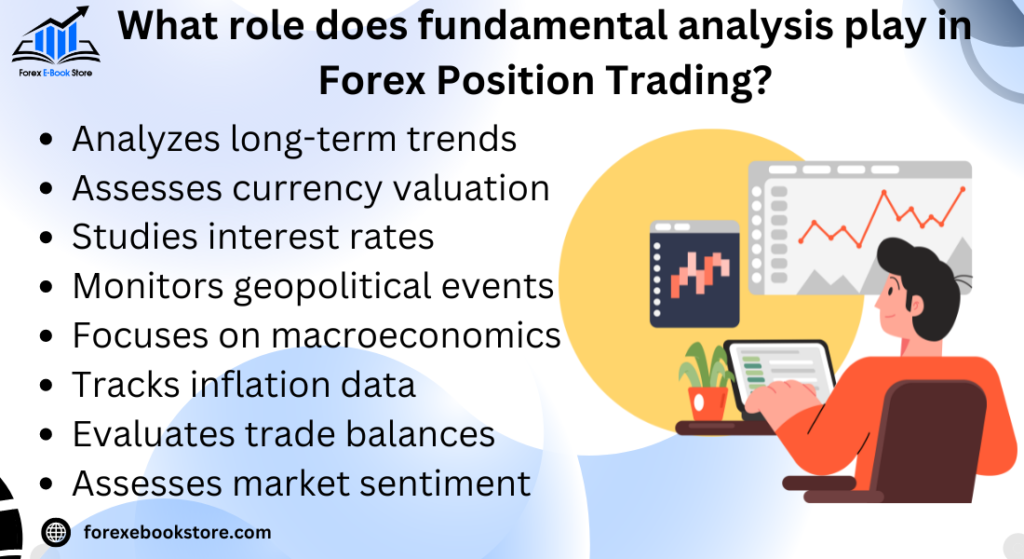
For example, a country with a strong economy, low inflation, and rising interest rates is more likely to see its currency appreciate in the long term. Position traders often analyze central bank policies, including monetary policy statements and interest rate decisions, to determine future currency trends. By combining fundamental analysis with technical analysis, position traders can make informed decisions and align their trades with both economic data and market sentiment.
Key Factors in Fundamental Analysis for Position Trading:
- Interest Rate Policies: Higher interest rates attract foreign investment, strengthening the currency.
- Inflation Data: Low inflation supports a strong currency, while high inflation typically weakens it.
- Economic Growth: Steady GDP growth indicates a healthy economy and a stronger currency.
How to Use Fundamental Data in Position Trading
- Monitor Central Bank Announcements: Keep track of interest rate changes and monetary policies.
- Follow Economic Reports: Stay updated on key economic data, such as inflation, employment, and GDP growth.
- Combine with Technicals: Use fundamental data to identify potential long-term trends and technical analysis for precise entry points.
How to manage risk effectively in Forex Position Trading?
Risk management is essential in forex position trading, as positions are held for longer periods, increasing exposure to market fluctuations and unforeseen events. Position traders must have a solid risk management plan in place to protect their capital from adverse price movements. A key part of this strategy involves using stop-loss orders, which automatically close a trade if the market moves against the trader by a predetermined amount.
Another critical aspect of managing risk in position trading is position sizing. Traders should only risk a small percentage of their capital on each trade, typically no more than 1-2%. This ensures that even if the market moves against them, their overall account balance remains protected. Additionally, position traders need to monitor economic and political events, as these can significantly impact currency movements over the long term.
Key Risk Management Techniques for Position Traders:
- Stop-Loss Orders: Protect your trades by setting stop-loss levels at critical price points to limit potential losses.
- Position Sizing: Never risk more than 1-2% of your total capital on a single trade.
- Monitor Long-Term Trends: Regularly check for changes in macroeconomic conditions or geopolitical events that could affect your trades.
Risk Management Tools for Forex Position Trading
- Trailing Stop-Loss: Adjusts as the trade moves in your favor, locking in profits while protecting against reversals.
- Diversification: Spread your trades across multiple currency pairs to reduce the impact of a negative move in one currency.
What are the advantages and disadvantages of Forex Position Trading?
Forex position trading offers several advantages, particularly for traders who prefer a more relaxed and long-term approach. One of the main benefits is that it allows traders to capture large price movements over time, maximizing potential profits without the need for constant monitoring. This is ideal for individuals who may not have time to actively manage trades on a daily basis. Additionally, position traders benefit from lower transaction costs, as they make fewer trades compared to short-term strategies like day trading or scalping.
However, position trading also comes with certain drawbacks. One significant disadvantage is the exposure to overnight risk and geopolitical events that can lead to significant price gaps when markets open. Furthermore, because trades are held for months or even years, traders need patience and the ability to withstand long periods of market fluctuation without acting emotionally.
Advantages of Forex Position Trading:
- Less Frequent Monitoring: Traders don’t need to constantly watch the markets, making it suitable for those with limited time.
- Potential for Larger Gains: Long-term positions allow traders to capture substantial price movements.
- Lower Transaction Costs: Fewer trades mean lower costs related to spreads and commissions.
Disadvantages of Forex Position Trading:
- Overnight Risk: Prolonged exposure to geopolitical or economic events can lead to unexpected market movements.
- Requires Patience: Traders must be comfortable with holding positions for extended periods, even during drawdowns.
Is Position Trading Right for You?
- Consider Time Commitment: If you prefer a hands-off approach, position trading may suit you.
- Weigh Risk Tolerance: Ensure you’re comfortable with the risks of holding long-term positions through market fluctuations.
How does leverage impact Forex Position Trading?
Leverage can significantly amplify both gains and losses in forex position trading, making it a double-edged sword. Position traders often use leverage to control large positions with relatively small amounts of capital, allowing them to maximize their potential profits from long-term trends. However, using high leverage also increases the risk, as even small adverse price movements can lead to significant losses, especially over extended periods.
Position traders must use leverage carefully, considering the long-term nature of their trades. A conservative approach to leverage, such as using lower ratios like 5:1 or 10:1, can help protect against large drawdowns. Furthermore, it’s essential to combine leverage with proper risk management techniques like stop-loss orders to mitigate potential losses and protect capital over time.
Impact of Leverage on Forex Position Trading:
- Increased Profit Potential: Leverage allows traders to control larger positions, maximizing profits from long-term trends.
- Higher Risk: High leverage increases the risk of significant losses, especially when holding trades over several months.
- Long-Term Exposure: With leverage, adverse price movements can compound over time, leading to larger drawdowns.
Tips for Using Leverage Safely in Position Trading
- Use Lower Leverage Ratios: Stick to conservative leverage ratios (5:1 or 10:1) to reduce exposure to risk.
- Combine Leverage with Risk Management: Always use stop-loss orders to limit potential losses and protect your capital.
- Monitor Margin Levels: Keep an eye on margin requirements to avoid margin calls during extended trades.
How to track long-term trends in Forex Position Trading?
Tracking long-term trends is crucial for successful forex position trading, as traders aim to profit from significant price movements that develop over weeks, months, or even years. Identifying these trends requires a combination of technical indicators and fundamental analysis to confirm the direction and sustainability of market movements. Position traders often rely on tools like moving averages, trendlines, and support and resistance levels to spot long-term trends.
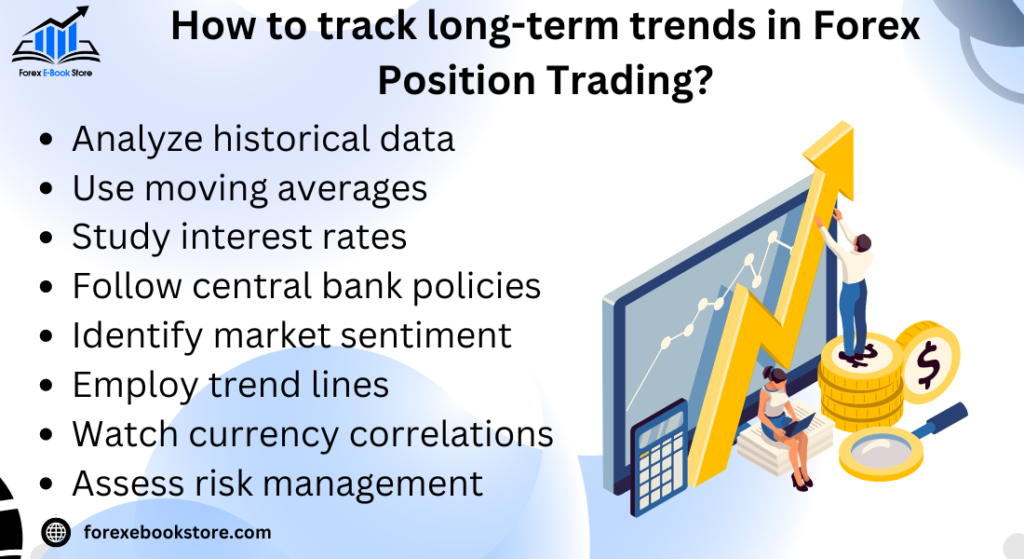
One of the most effective indicators for tracking long-term trends is the 200-day moving average. This indicator helps traders identify the overall direction of a currency pair, smoothing out daily price fluctuations. Additionally, trendlines can be drawn on higher time frames (weekly or monthly charts) to confirm whether a currency pair is consistently trending upward or downward. By combining these technical tools with fundamental analysis, position traders can make informed decisions about when to enter or exit a trade.
Key Techniques for Tracking Long-Term Trends:
- 200-Day Moving Average: Helps confirm the overall market direction, reducing the impact of short-term volatility.
- Trendlines: Used on higher time frames to visually track the direction of the market.
- Support and Resistance Levels: Identify key price levels that signal potential trend reversals.
Tools for Long-Term Trend Analysis
- Moving Average Crossovers: Look for the crossover of shorter moving averages with the 200-day moving average to confirm trend shifts.
- Relative Strength Index (RSI): Use RSI to identify overbought or oversold conditions within long-term trends.
What tools and platforms are essential for Position Traders?
Position traders need reliable trading platforms that offer advanced charting capabilities, access to real-time data, and fundamental analysis tools. Since position trading focuses on long-term trends, traders should choose platforms that provide both technical and fundamental analysis features to support their decision-making process. Popular platforms like MetaTrader 4/5 (MT4/MT5) and TradingView are excellent choices due to their advanced charting tools, custom indicators, and access to economic news feeds.
Additionally, tools like economic calendars and fundamental analysis platforms (e.g., Forex Factory and Trading Economics) are crucial for tracking important economic data that can affect long-term currency trends. Position traders should also look for platforms that offer risk management tools, such as stop-loss orders and trailing stops, to protect their trades while allowing for potential profit growth.
Essential Tools for Forex Position Traders:
- MetaTrader 4/5 (MT4/MT5): Provides advanced charting tools, automated trading, and access to a wide range of indicators.
- TradingView: Offers an intuitive interface with advanced charting and social features where traders can share ideas and strategies.
- Economic Calendars: Platforms like Forex Factory and Trading Economics provide real-time updates on important economic events.
Features to Look for in a Position Trading Platform
- Advanced Charting Tools: Look for platforms that support long-term trend analysis with multiple time frames.
- Risk Management Features: Ensure the platform allows for setting stop-loss and trailing stop orders to manage long-term trades effectively.
- Fundamental Analysis Integration: Choose platforms that offer news feeds, economic reports, and tools for analyzing macroeconomic data.
What are the common mistakes made in Forex Position Trading and how to avoid them?
Forex position trading requires patience, discipline, and a long-term perspective. However, many traders make common mistakes that can undermine their success. One of the most frequent errors is overtrading or entering too many positions without fully considering the broader market context. In position trading, the goal is to hold fewer, high-quality trades that align with long-term trends, rather than constantly seeking new opportunities.
Another common mistake is ignoring fundamental analysis. While technical analysis is essential, position traders who disregard the impact of economic data, interest rate changes, or geopolitical events are more likely to experience significant losses. Additionally, lack of proper risk management is a critical error. Failing to use stop-loss orders or risking too much capital on a single trade can lead to devastating losses, especially in volatile markets.
Common Mistakes in Forex Position Trading:
- Overtrading: Entering too many positions or frequently changing trades undermines the long-term nature of position trading.
- Neglecting Fundamental Analysis: Relying solely on technical analysis without considering macroeconomic factors can lead to poor decision-making.
- Improper Risk Management: Not setting stop-loss orders or overleveraging positions increases the risk of significant losses.
How to Avoid Common Position Trading Mistakes
- Stick to Long-Term Strategies: Avoid entering trades based on short-term market movements; focus on broader trends and fundamentals.
- Use a Balanced Approach: Combine both technical and fundamental analysis to inform your trades.
- Implement Risk Controls: Always use stop-loss orders and keep position sizes in check to manage risk effectively.
What are the psychological challenges of Forex Position Trading?
Forex position trading requires a high level of patience and emotional discipline, as trades can remain open for extended periods, sometimes spanning months or even years. One of the biggest psychological challenges is holding trades through market volatility without reacting impulsively to short-term price movements. This can be particularly difficult when a trader sees temporary losses or market corrections but must stick to their long-term strategy.
Another common challenge is overconfidence after a series of successful trades. Traders may believe they have mastered the market and start to take on more risk or ignore their trading plan. This can lead to overleveraging or abandoning fundamental risk management principles. Additionally, fear of missing out (FOMO) can drive traders to enter trades without proper analysis, simply because they see a strong price movement, which might not align with their long-term strategy.
Psychological Challenges in Forex Position Trading:
- Patience in Volatile Markets: Traders need to resist the urge to close positions during short-term volatility, staying committed to their long-term strategy.
- Overconfidence: After a string of successful trades, traders might increase their risk, potentially leading to larger losses.
- FOMO (Fear of Missing Out): Entering trades impulsively without fully analyzing long-term trends can derail trading strategies.
Tips for Overcoming Psychological Challenges
- Stick to Your Plan: Always follow your predefined trading strategy and avoid reacting to short-term market noise.
- Track Emotional Responses: Use a trading journal to document emotional reactions to market events and identify areas where discipline is needed.
- Take Breaks: Step away from the market periodically to reduce emotional stress, especially during volatile periods.
Is Forex Position Trading suitable for beginners?
Forex position trading can be suitable for beginners, especially those who prefer a more passive trading approach and have the patience to wait for long-term trends to develop. Unlike day trading or swing trading, position trading does not require constant market monitoring, which makes it less overwhelming for new traders. Beginners can focus on understanding the broader macroeconomic factors, such as interest rates and GDP growth, that drive long-term currency trends.
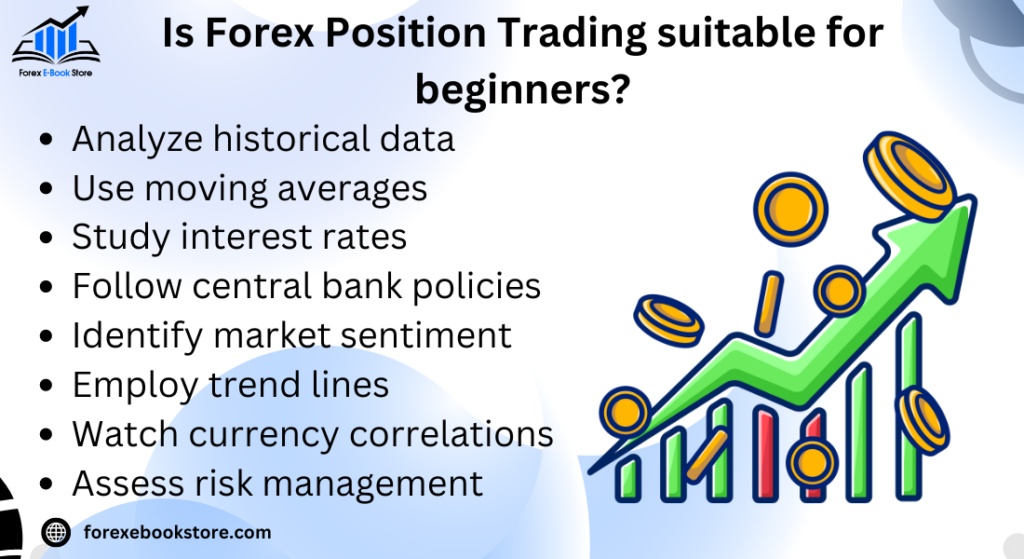
However, beginners need to understand that position trading still requires a deep understanding of both technical analysis and fundamental analysis. While it allows for a more relaxed pace, the long-term nature of this strategy means that beginners must have the discipline to stick to their trading plan, even during market fluctuations. Starting with a demo account is recommended for new traders to practice position trading without risking real money.
Why Forex Position Trading is Suitable for Beginners:
- Less Time-Intensive: Beginners don’t need to constantly monitor the market, making it ideal for those who prefer a more hands-off approach.
- Focus on Fundamentals: New traders can learn the key economic factors driving long-term trends, such as interest rates and GDP.
- Lower Frequency of Trades: Position trading involves fewer trades, reducing the pressure to constantly analyze the market.
Tips for Beginners in Forex Position Trading
- Start with a Demo Account: Practice your strategy with virtual money to understand the dynamics of long-term trading.
- Focus on Learning Fundamentals: Understand how economic factors like interest rates and inflation affect currency trends.
- Be Patient: Develop the discipline to stick to your long-term strategy without getting distracted by short-term market movements.
What are the tax implications of Forex Position Trading?
Understanding the tax implications of forex position trading is crucial for traders, as profits generated from long-term trades are typically subject to taxation in most jurisdictions. The exact tax treatment depends on the country where the trader is based, as well as the type of trading account and assets involved. In many countries, profits from forex trading are considered capital gains and are subject to capital gains tax.
For example, in the U.S., forex traders may be taxed under Section 1256 or Section 988 of the IRS code. Section 1256 applies to certain forex futures contracts and offers favorable tax treatment, with 60% of gains taxed as long-term capital gains and 40% as short-term. On the other hand, spot forex trades—which are more common in position trading—are typically taxed under Section 988 as ordinary income. Traders should consult a tax professional to ensure they are compliant with local tax laws and are taking advantage of any potential deductions for losses or trading expenses.
Key Tax Considerations for Position Traders:
- Capital Gains Tax: In many countries, profits from long-term forex trades are considered capital gains and subject to taxation.
- Section 1256 vs. Section 988 (U.S.): Some traders may benefit from the favorable tax treatment under Section 1256, while others are taxed as ordinary income under Section 988.
- Deductible Expenses: Traders may be able to deduct certain expenses, such as losses, trading fees, and educational costs, to reduce their taxable income.
How to Handle Taxes in Forex Position Trading
- Consult a Tax Professional: Ensure compliance with local tax regulations and explore opportunities for tax deductions.
- Keep Detailed Records: Maintain thorough records of all trades, profits, and expenses to simplify tax reporting.
- Understand Your Country’s Tax Rules: Different countries have varying tax treatments for forex trading, so make sure to understand the specific rules that apply to you.
How to stay updated with market news for Forex Position Trading?
Staying updated with market news is crucial for successful forex position trading, as long-term trends are heavily influenced by global economic events and political developments. Position traders must keep track of macroeconomic data such as interest rate decisions, GDP reports, inflation rates, and employment statistics to anticipate shifts in currency trends. Additionally, geopolitical events and central bank announcements can have a significant impact on currency markets, making it important to stay informed.
A useful tool for staying updated is an economic calendar that tracks upcoming reports and announcements that can affect the forex market. Platforms like Forex Factory or Trading Economics provide real-time updates on key economic indicators. Additionally, traders can set up news alerts on platforms like Bloomberg or Reuters to receive immediate notifications about major events that could impact their trades.
Ways to Stay Updated with Market News for Position Trading:
- Use Economic Calendars: Track upcoming reports like interest rate decisions and GDP releases to anticipate long-term currency trends.
- Set News Alerts: Platforms like Bloomberg or Reuters allow traders to receive real-time notifications on major economic events.
- Follow Financial News Sources: Regularly check financial news from trusted sources such as CNBC, Reuters, and Bloomberg.
Top Platforms for Market News
- Forex Factory: Offers a comprehensive economic calendar with real-time updates on major economic events.
- Bloomberg/Reuters: Leading financial news sources with real-time coverage of global economic and political developments.
- TradingView: A charting platform that also integrates news features and economic updates for informed trading.
Can Forex Position Trading be automated?
Yes, forex position trading can be automated through the use of algorithmic trading systems or Expert Advisors (EAs) on platforms like MetaTrader 4/5 (MT4/MT5). Automated trading allows traders to execute long-term trades based on predefined conditions without manual intervention, ensuring that trades are executed consistently according to a strategy. This can be especially beneficial for position traders, as it reduces the need for constant monitoring and helps maintain emotional discipline by eliminating human error.
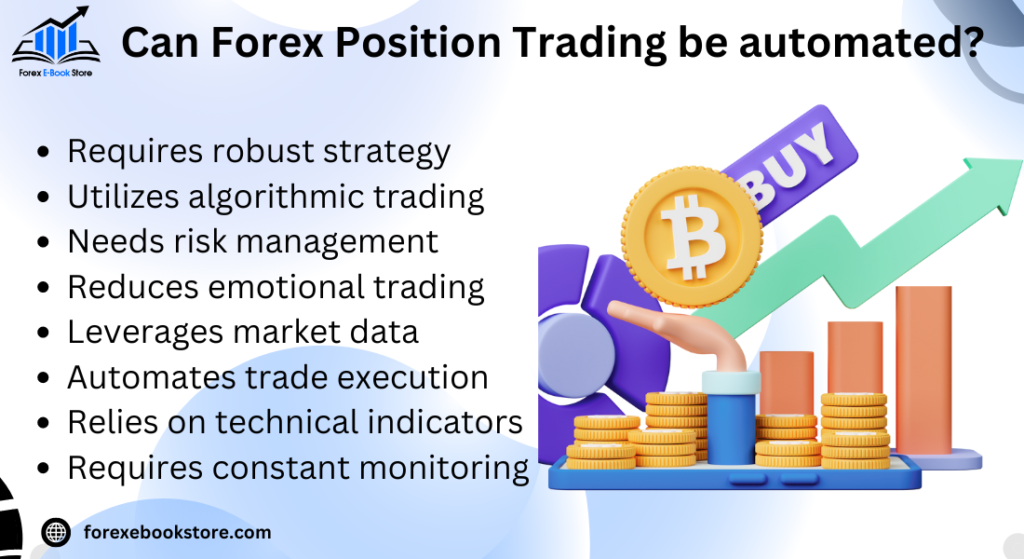
However, automating forex position trading requires thorough backtesting to ensure that the algorithm performs well under various market conditions. Since position trading deals with long-term trends, it’s crucial to design systems that account for potential shifts in economic conditions or market sentiment. Automated systems can also be set to manage risk by using trailing stop-loss orders to protect profits as the trade moves in the trader’s favor.
Pros of Automating Forex Position Trading:
- Consistency: Automated systems ensure that trades are executed based on set rules, eliminating emotional decisions.
- Time-Saving: Automation allows traders to focus on strategy development without constantly monitoring the market.
- Risk Management: Algorithms can be programmed to adjust stop-loss levels and manage risk effectively.
Cons of Automating Forex Position Trading:
- Limited Flexibility: Automated systems may struggle to adapt to unforeseen events or sudden market shifts.
- Technical Issues: System malfunctions or poor internet connectivity can lead to missed trades or execution errors.
How to Implement Automation in Position Trading
- Backtest Your System: Use historical data to test your automated strategy across various market conditions.
- Monitor the System: Even though it’s automated, it’s important to regularly check the system’s performance to ensure it’s functioning as expected.
- Choose Reliable Platforms: Use platforms like MT4 or MT5, which offer robust support for automated trading systems.
Conclusion
In conclusion, Forex Position Trading Explained provides traders with a clear understanding of how to capitalize on long-term trends in the forex market. By holding positions for extended periods, often months or years, position traders can benefit from broader macroeconomic movements and avoid the daily volatility that affects short-term strategies. This approach requires patience, a solid understanding of fundamental and technical analysis, and effective risk management to maximize potential gains while minimizing risks.
For traders comparing strategies, it’s important to note how Forex Swing Trading Explained differs from position trading. While swing trading focuses on capturing medium-term price movements over days or weeks, position trading looks at the bigger picture, aiming for even larger market moves over longer time frames. Both strategies have their advantages, and understanding these differences allows traders to choose the method that best aligns with their goals, time commitment, and risk tolerance.












